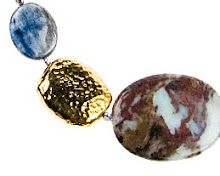Italian factories are known to be the best producers of chains. In fact, the best quality machine made sterling silver chains are made in Italy. Most of the machines that are now housed in China, the next up and coming high quality manufacture, are designed in Italy. However, Italians are less known for their sterling silver components, or findings.
This is largely because components, outside of stampings, require casting and more work. Italian labour is very expensive, not only because the country is very pro-labour union, having some of the longest holiday laws of the western world, but also because they are not willing to work for very little. I've met many Italian producers, and I think they value their leisure time more than most. Their attitude about business is also unique. They do not like to lower their price and take offence to haggling almost as much as the French. (Digression: an interesting note on culturally views on haggling. In terms of being the most offended by haggling, I am sure it is the Japanese, followed by the Germans. Culturally, the Japanese set prices at what they think is reasonable and sustainable for both the purchaser and the seller. That is why electronic goods, and all other things, are prices the same regardless of where it is in the product life cycle. You pay the same at initial launch or much later, unlike American companies, that like to take advantage of the "newness factor", or the willingness by the market "leaders" to pay. So, haggling for Japanese is truly an insult and is usually seen as an embarrassment for both parties.) Italians don't make too many sterling silver components, but when they do, the quality is invariably excellent.
The most common Italian sterling silver components are stampings. This is a method of component manufacturing whereby a set of die cuts are made and sheets of silver is cut and pressed into the desired finish. These components tend to be light weight, though expensive by cost per gram analysis. There are design limitations to sterling silver stampings. They cannot be thick. Otherwise the knives can't cut through, or not easily and cheaply. Furthermore, the thickness of the piece is even throughout because it is from a sheet. However, the Italians have been very creative in making stampings that are waved and with plethora of unusual textures. You can see an example of this here.
Italian producers make very interesting hollow-form sterling silver components. They tend to be larger and more dramatic, and they are definitely unusual. The prices are more expensive because hollow form sterling silver components take longer to produce, with more steps in production and requiring more labour.
Another type of sterling silver components popular in Italy is flattened components. These are regular casted components which are then rolled in heavy rollers. They are flattened and sometimes take on usual and unexpected shapes. You can see examples of this here and here.
Italian manufacturers pride themselves in creating elegant and unique designs that are well made. It is what they stand for and it is a reflection of their lifestyle. Italian sterling silver findings are some of the best in the world. If it suits your style, you can trust their quality.

No comments:
Post a Comment